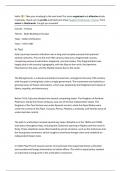Hello ! Take your studying to the next level! For more organized and effective study
materials, check out my profile and flashcard shop Maggie's Flashcards - Payhip. From
notes to flashcards, I've got you covered!
Course : History
Theme : State Building in Europe
Topic : Italian Unification
Years : 1815-1861
In Text
Italy's journey towards unification was a long and complex process that spanned
several centuries. Prior to the mid-19th century, Italy was a fragmented country,
comprising various small states, kingdoms, and city-states. This fragmentation was
largely due to the country's geography, with the Alps to the north, the Apennine
Mountains to the east, and the Mediterranean Sea to the south.
The Risorgimento, a cultural and political movement, emerged in the early 19th century
with the goal of uniting Italy under a single government. The movement was fueled by a
growing sense of Italian nationalism, which was sparked by the Enlightenment ideals of
liberty, equality, and democracy.
Before 1815, Italy was divided into several competing states. The Kingdom of Sardinia-
Piedmont, led by the House of Savoy, was one of the few independent states. The
Kingdom of the Two Sicilies was under Spanish control, while the Papal States were
under the control of the Pope. Tuscany, Parma, Modena, Lombardy, and Venetia were all
under Austrian control.
The path to unification involved several key steps. Rebellions in the 1820s and 1830s
took place throughout Italy, including the Carbonari uprising in Naples and the revolt in
Sicily. These rebellions were often fueled by secret societies, such as the Carbonari and
the Young Italy movement, which sought to overthrow foreign rulers and establish an
independent Italian state.
In 1849, Pope Pius IX issued a series of encyclicals that supported Italian unification
and condemned foreign intervention in Italian affairs. This shift in papal policy marked
an important turning point in the unification movement.
, Camillo Benso di Cavour, the Prime Minister of Piedmont-Sardinia, began secret
negotiations with Napoleon III of France in 1858. These negotiations aimed to secure
French support for Italian unification and led to the formation of an alliance between
Piedmont-Sardinia and France.
In 1860, Giuseppe Garibaldi's Expedition of the Thousand successfully conquered
much of southern Italy, leading to the annexation of Sicily and Naples by Piedmont-
Sardinia. There were three main views on Italian unification: Republicans believed that a
democratic government where power was held by the people through elections was
best; Federalists hoped for a decentralized system where each state maintained some
degree of autonomy within a federal framework; and Monarchists supported the
restoration of a unified monarchy under the last royal family of Italy.
In 1861, Victor Emmanuel II of Piedmont-Sardinia was crowned King of Italy, marking
the beginning of a unified Italian state. However, it would take several more years for
Italy to be fully unified under a single government.




